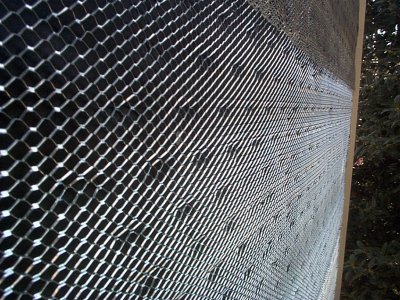By Reggie Bullard
|
|
I am having a
house built here in
Yuma, Arizona.
Yes it gets hot here with 120 degree days in the summer. Great winter
weather
though (68 to 77 all winter). My question is: Half inch CDX plywood was put around the entire house. The windows were then placed. Then lath/tar paper will cover then entire exterior. Then two inches of Celotex (polyisocyanurate) board insulation will cover the entire exterior. This is the kind with the foil facing on both sides. Then chicken wire. Then I have a choice of three coat stucco (scratch, brown, color), two coat (brown, color then electromeric paint), or synthetic stucco. I am leaning toward the two coat system. The one coat
(synthetic)
turned me off because you can not only jam a pencil right through a
house
with this installed but the problems associated The two coat sounded better because of the electromeric paint. If I ever get tired of the color, I just paint the house. The other benefit I believe is that it is flexible and would cover most hairline cracks. The last real benefit is that it is less weight than the 3 coat system. I would worry about a heavy three coat system hanging two inches away from the plywood wall. Might bend or pop the nails holding the chicken wire. Well, on to my question: A friend built a similar house.
Only he
used OSB plywood over his entire house instead of CDX. He then put 2
inches
of Celotex insulation and then had a three coat stucco applied over the
entire house. Well, the entire house cracked. I mean there were huge
cracks
at every stud (or where there were plywood joints). To make matters
worse,
the city Since my house is so similar, I am concerned. 1. Did they let the wood framed house dry for at least 30 days to let the house do all its twisting and warping prior to stucco? 2. Did they let the house sit for 30 days after the scratch coat? 3. Did they do a bad mix of stucco. 4. When they cut out the 4x4 section of wall, they saw that the chicken wire was embedded a little into the Celotex. I remember the days when nails with cardboard was used and the nails stuck out about 1/4 inch and you wrapped wire around it. This way the wire was embedded into the stucco. Chicken wire just kind of sticks to the bottom of the stucco. However, I have seen a lot of homes just like this with Zero cracks. 5. This is the one that concerns me the most. Did the fact that dow blueboard was not used be the problem. Blueboard has dimples and grooves for water and stucco adhesion. In fact I have seen stucco pulled off an existing stucco wall and the foam will come off with it as though the stucco had chemically bonded to the blueboard. I assume this would not happen with a stucco, foil faced insulation material (Celotex). This might be bad? 6. It was not summer here when they stuccoed this house so I believe lack of moisture during curing was not a problem Do you have any suggestions? The truth is, the only house we have ever done There isn't a single tiny crack in the whole thing, The fact that the cracked up house had the stucco I think on the cracked up house if the lath was self
furring, We let the scratch coat sit 2 days. The mix was probably
I don't do the new 2 coat( or what some people call I have discovered ways to cut down the cracks to none or
at 35 years of experience doesn't mean a damn thing to I plan to publish our 12 point method for limiting cracks
this Thanks a bunch. I think you may have solved my problem.
They used diamond mesh on one of our city buildings and
there I suspect though, that the two coat stucco might not cover
the I like the idea of having the foam between the sheathing |
monthly columns: Wive's tales 12 point crack attack next question
